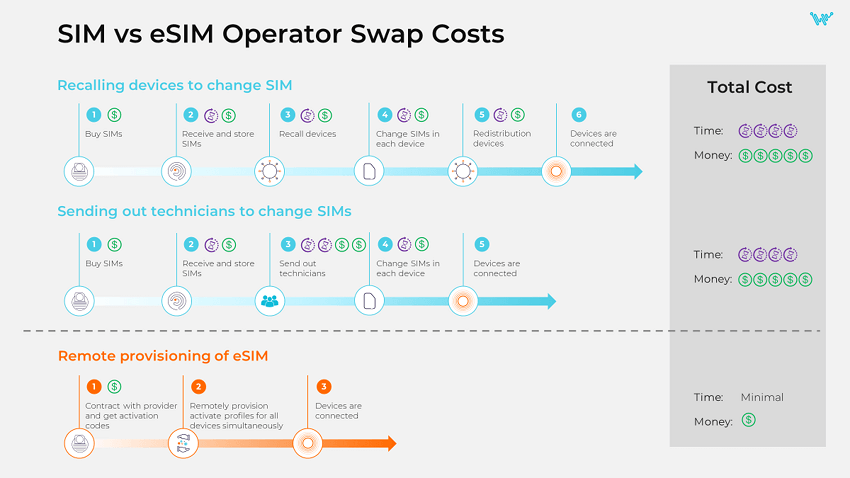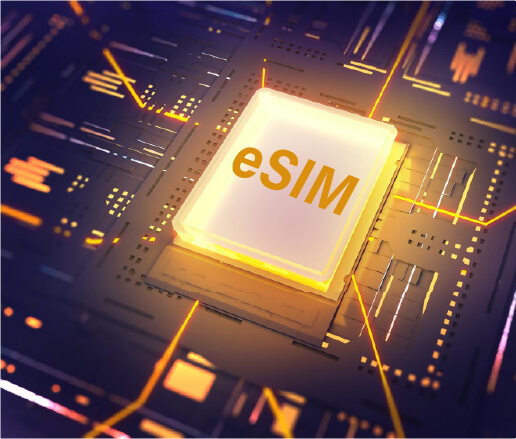Exploring the strategic advantages of eSIM for cost-effective IoT connectivity
by Webbing Team
When discussing IoT connectivity, we often focus on the technical aspects such as coverage, latency, network reliability, and the latest advancements in communication technology. While these are undoubtedly crucial elements for any IoT ecosystem, there’s a broader, more strategic layer that can significantly impact the success of IoT deployments: cost management. As organizations deploy and scale their IoT solutions, the operational costs associated with maintaining connectivity across devices and locations can become a pressing concern.
eSIM technology has emerged as a game-changing solution, opening new connectivity possibilities for device manufacturers and enterprises. eSIM, also known as the eUICC, moves beyond the traditional SIM cards: it can be remotely programmed and reprogrammed, can host multiple profiles, and new profiles can be downloaded and activated at any time with Over-The-Air (OTA) provisioning, regardless of a device’s location.
Yet, the value of eSIM in IoT is not just in its technical merits but in its ability to deliver long-term cost savings across industries. Whether it’s reducing the costs associated with SIM card procurement, handling logistics, or managing network subscriptions across different regions, eSIM offers a strategic advantage. By enabling devices to connect to multiple networks without needing to swap physical cards, eSIM brings many other benefits to enterprises, from enhanced reliability and flexibility to compliance with local regulations. All these advantages ultimately translate to lower costs for managing device fleets, simplified operations, and improved overall efficiency.
As organizations look for innovative ways to optimize their IoT infrastructure, adopting eSIM technology is becoming an essential step in reducing operational costs while ensuring reliable and efficient connectivity. Here’s how eSIM plays a critical role in managing and reducing operational expenses in various use cases:

Simplifying Production, Distribution and Deployment
Manufacturers of cellular-enabled IoT devices – be it a connected car or a smart camera – might not always know where these devices will be deployed or used. So, before there was eSIM, shipping connected products to various markets meant either having multiple production lines to make different versions of the same product with different carrier SIMs or managing a process of buying and keeping the inventory of local SIMs and swapping them when devices reach their destination. This can significantly increase the cost of manufacturing, supply and logistics.
Oftentimes, enterprises that deploy connected devices might purchase more devices than they initially need to get a better price per unit. For them, too, it was important to have and manage a stock of SIMs for further use when scaling or redeploying their devices.
With eSIM, device manufacturers and enterprises deploying these devices don’t need to worry about specific SIMs for specific regions at the stage of production, purchasing and shipping. They can use a single stock keeping unit (SKU) eSIM for all their devices. It considerably simplifies manufacturing and supply chain management and reduces costs.
Streamlining Management
One of the main benefits of eSIM for enterprises that deploy IoT devices is flexibility and convenience of management. The ability to remotely activate connected devices, monitor and control their data usage and change mobile network providers on the fly at any point in their lifecycle makes IoT deployments easier and more cost-efficient. For example, a change of local provider that before would have taken weeks and require changing SIMs in the devices manually, now can be done within hours.
This applies to scaling as well: no matter how many devices need to be connected and where, they can be activated and provisioned remotely over the air. And all this also saves costs and time on device maintenance – because it eliminates the need for technicians to change SIMs in devices in the field if, for example, the contract is expired.

Reduced Downtime
Aside from saving on maintenance and logistics, simplified management helps significantly reduce downtime. Whether it’s a SIM activation, lost connection, or a need for a firmware update, with eSIM there’s no need to wait for a technician to arrive on-site or the device is delivered to the service station. It is especially critical for connected devices in remote locations, such as cameras and sensors at oil & gas fields or off-grid charging stations for electric vehicles.
Remote SIM provisioning ensures devices can be quickly activated and updated without requiring manual intervention, reducing downtime and associated operational inefficiencies.
Reduced Roaming Fees
Roaming is the simplest way to ensure global coverage, so up to half of all cellular IoT connections may rely on it – whether a connected device is moving between various countries and regions or is static and needs to roam on other operator’s network to ensure stable connectivity. With eSIM, devices can easily switch between multiple mobile carriers, which means they can use local data plans without a physical SIM swap. This enables businesses to choose the best network for their needs, helping to minimize roaming costs when devices are used in different regions or countries.

Webbing’s Solution
Our eSIM solution, WebbingCTRL, ensures failover connectivity with the capability of using multiple mobile carrier profiles, easily switching carriers at any time with zero integration, and an option to fall back from a failing profile to a different profile without any need to communicate with a remote server.
WebbingCTRL enables organizations to remotely add, remove, and swap operators for any number of IoT deployments immediately without operator integration or collaboration. It also provides a centralized way to manage eSIMs/SIMs lifecycle and profile inventory, as well as visibility into device data usage. Companies can set up business rules that would allow devices to change the serving operator automatically under specific conditions, such as location, country, loss of connectivity or even after a certain amount of time. Webbing’s eSIM is aligned with the GSMA SGP.32 IoT eSIM specification, which means it will be fully compatible with the new standard when it becomes ubiquitous. The WebbingCTRL platform can work with both SGP.32 and SGP.22 standards, and also supports M2M devices for relevant use cases. It provides a single pane of glass to manage all devices deployed regardless of standards used.
More than 1 million WebbingCTRL eSIMs/SIMs have already been deployed globally. Our eSIM cards have helped businesses across various industries achieve cost savings in multiple projects, such as streamlining logistics and reducing expenses for live broadcasting of the 2023 G20 Summit, or lowering installation overhead costs for mobile security units.
Using eSIM technology helps reduce operational costs, but the cost benefits can be further amplified when combined with Webbing’s global connectivity solution. With Webbing’s partner network of over 600 mobile operators worldwide, our connectivity solution gives access to several carriers’ networks at any location, ensuring continuous connectivity without having to contract with multiple operators.
Webbing’s distributed core network with local breakouts, multiple network solution, and data server redundancy provides connectivity stability and low latency. It also allows to easily comply with local regulators’ requirements and helps to adapt to any changes in legislation. Besides, it gives enterprises the ability to quickly scale their deployments or adjust their existing fleet management to any business scenarios.
Moreover, a flexible approach to data packages allows us to tailor our connectivity offering for every customer based on the type of connected devices and their data consumption needs as well as the locations where the devices are used, aiming at overall optimization of the total cost of operations for the client.
Contact us today to learn how Webbing eSIM and our global connectivity solution can help you reduce costs and optimize your IoT deployments.




